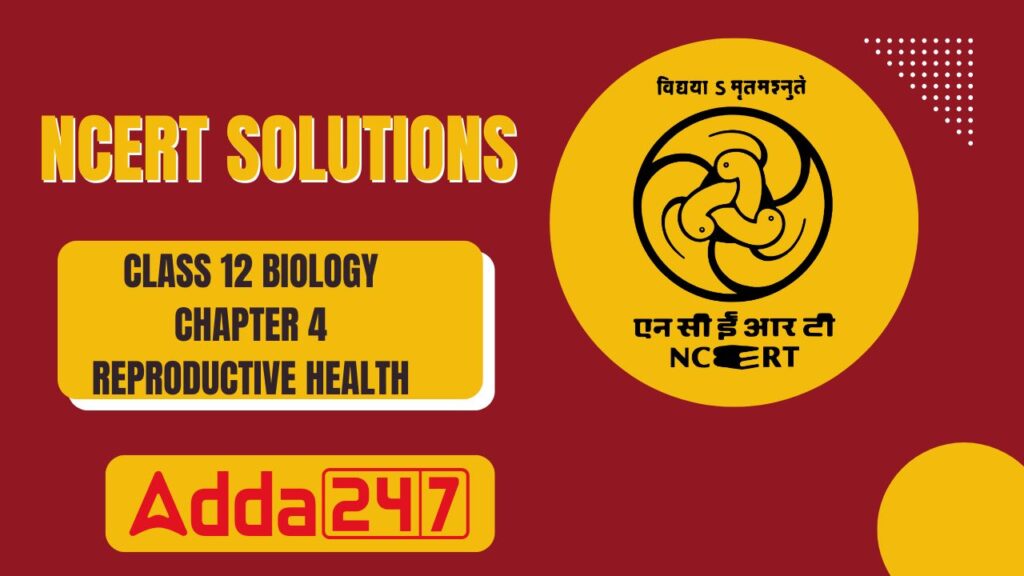
Reproductive health, in simple terms, refers to healthy reproductive organs with normal functions. This is a true composition of physical health, mental health, and social well-being. All the students who have got admission into the class 12th biology stream will be studying topics like What is Reproductive Health?, Importance of Reproductive Health, Family Planning, Sexually Transmitted Diseases (STDs), Family Planning and Population Control, etc., in their Chapter 4 of the NCERT Class 12 Biology textbook. To help students complete their preparation for the final board exams, we have added the NCERT Solutions for Class 12 Biology Chapter 4 Reproductive Health in the article below.
Overview of Class 12 Biology Chapter 4
The students, while starting their studies, must always first get an overview of the chapter or topic they are studying, as it will help them understand the importance and necessity of it. Below, we have added the overview of the Class 12 Biology Chapter 4:
- Reproductive Health – Problems and Strategies: Importance of education, awareness, and access to healthcare.
- Population Explosion and Birth Control: Causes, consequences, and contraceptive methods.
- Medical Termination of Pregnancy (MTP): Procedures, ethical issues, and legal aspects.
- Sexually Transmitted Infections (STIs): Causes, prevention, and treatment.
- Infertility and Assisted Reproductive Technologies (ART): IVF, GIFT, ZIFT, IUI, and surrogacy.
- Significance: Promotes understanding of reproductive health issues, crucial for social awareness and medical entrance exams.
NCERT Solutions for Class 12 Biology Chapter 4 Reproductive Health
During the preparation and revision phase, students get stuck with several questions about the chapter or topic, hence, we have shared the NCERT Solutions for Class 12 Biology Chapter 4 Reproductive Health below:
Question 1: What do you think is the significance of reproductive health in a society?
Answer: Reproductive health is significant in a society because:
- Physical Well-being: Ensures healthy functioning of reproductive organs, preventing issues like infertility and STIs.
- Mental and Social Health: Promotes awareness, reduces stigma around reproductive issues, and supports informed decision-making (e.g., family planning).
- Population Control: Encourages the use of contraceptives to manage population growth, reducing strain on resources.
- Gender Equality: Empowers individuals, especially women, by providing access to reproductive choices and healthcare.
- Disease Prevention: Educates about STIs, their prevention, and treatment, reducing public health risks.
- Healthy Future Generations: Ensures safe pregnancies and healthy offspring through proper maternal and child healthcare.
Question 2: Suggest the aspects of reproductive health which need to be given special attention in the present scenario.
Answer: Aspects of reproductive health needing special attention include:
- Awareness and Education: Promoting knowledge about safe sex, contraception, and STIs among adolescents and adults.
- Access to Healthcare: Ensuring affordable and accessible reproductive health services, especially in rural areas.
- Contraception: Encouraging the use of effective contraceptive methods to control population growth and prevent unplanned pregnancies.
- STI Prevention and Treatment: Increasing awareness about sexually transmitted infections (e.g., HIV/AIDS) and ensuring early diagnosis and treatment.
- Maternal Health: Improving prenatal and postnatal care to reduce maternal and infant mortality.
- Infertility Management: Providing access to assisted reproductive technologies (ART) for infertile couples.
- Counseling and Support: Addressing mental health and social stigma related to reproductive issues like infertility or MTP.
Question 3: Is sex education necessary in schools? Why?
Answer: Yes, sex education is necessary in schools because:
- Awareness: Educates students about reproductive health, puberty, and safe sexual practices, reducing misinformation.
- STI Prevention: Teaches about sexually transmitted infections and their prevention, promoting safe behaviors.
- Contraception Knowledge: Informs about contraceptive methods, aiding in family planning and preventing unintended pregnancies.
- Reducing Stigma: Encourages open discussions about reproductive health, reducing taboos and myths.
- Empowering Choices: Helps adolescents make informed decisions, promoting gender equality and personal responsibility.
- Preventing Abuse: Educates about consent and healthy relationships, reducing risks of sexual abuse or exploitation.
Question 4: What are the suggested reasons for population explosion?
Answer: Reasons for population explosion include:
- High Birth Rates: Lack of awareness about family planning and contraception in many regions.
- Low Death Rates: Improved healthcare and medical advancements (e.g., vaccines, better nutrition) increase life expectancy.
- Cultural Factors: Preference for large families in some societies due to social or economic reasons (e.g., agricultural labor).
- Lack of Education: Limited education, especially among women, reduces awareness of reproductive health and contraception.
- Poverty: Economic constraints lead to reliance on children for support, encouraging larger families.
- Early Marriages: Early marriages increase the reproductive lifespan, leading to more births.
- Religious and Social Beliefs: Some communities oppose contraception due to traditional or religious views.
Question 5: Is the use of contraceptives justified? Give reasons.
Answer: Yes, the use of contraceptives is justified because:
- Population Control: Helps manage population growth, reducing pressure on resources like food, water, and healthcare.
- Prevent Unplanned Pregnancies: Allows couples to plan family size, improving financial stability and quality of life.
- Health Benefits: Reduces risks of maternal and infant mortality by spacing pregnancies and preventing high-risk pregnancies.
- STI Prevention: Barrier methods (e.g., condoms) protect against sexually transmitted infections like HIV/AIDS.
- Women’s Empowerment: Enables women to make reproductive choices, supporting education and career opportunities.
- Economic Stability: Smaller families reduce economic burdens, improving living standards.
Question 6: Removal of gonads cannot be considered as a contraceptive option. Why?
Answer: Removal of gonads (testes in males, ovaries in females) cannot be considered a contraceptive option because:
- Permanent Sterility: Gonad removal (e.g., castration or oophorectomy) causes irreversible infertility, whereas contraception aims for reversible or temporary prevention of pregnancy.
- Hormonal Imbalance: Gonads produce sex hormones (testosterone, estrogen, progesterone); their removal disrupts hormonal balance, leading to health issues like osteoporosis or loss of secondary sexual characteristics.
- Surgical Risks: Gonad removal is a major surgical procedure with risks like infection or complications, unlike safer contraceptive methods (e.g., condoms, pills).
- Purpose of Contraception: Contraception aims to prevent pregnancy while preserving reproductive potential, which gonad removal does not achieve.
Question 7: Amniocentesis for sex determination is banned in our country. Is this ban necessary? Why?
Answer: Yes, the ban on amniocentesis for sex determination is necessary because:
- Preventing Female Foeticide: Amniocentesis was misused to determine the sex of the fetus, leading to selective abortions of female fetuses, contributing to skewed sex ratios.
- Gender Equality: The ban promotes equal value for male and female children, addressing societal biases against females.
- Ethical Concerns: Sex determination for non-medical reasons violates ethical principles of respecting life and gender equality.
- Legal Protection: The ban (under the Pre-Conception and Pre-Natal Diagnostic Techniques Act, 1994) prevents illegal practices and protects human rights.
- Medical Use Allowed: Amniocentesis is permitted for detecting genetic disorders, ensuring its ethical medical application.
Question 8: Suggest some methods to assist infertile couples to have children.
Answer: Methods to assist infertile couples include Assisted Reproductive Technologies (ART):
- In Vitro Fertilization (IVF): Sperm and egg are fertilized outside the body in a lab, and the embryo is transferred to the uterus.
- Gamete Intra-Fallopian Transfer (GIFT): Sperm and egg are placed in the fallopian tube for fertilization.
- Zygote Intra-Fallopian Transfer (ZIFT): Fertilized zygote is transferred to the fallopian tube.
- Intra-Uterine Insemination (IUI): Sperm is directly injected into the uterus to facilitate fertilization.
- Surrogacy: Another woman carries and delivers the baby for the infertile couple, using their gametes or donor gametes.
- Intra-Cytoplasmic Sperm Injection (ICSI): A single sperm is injected into an egg to achieve fertilization, used in cases of low sperm count.
Question 9: What are the measures one has to take to prevent contracting STDs?
Answer: Measures to prevent sexually transmitted diseases (STDs) include:
- Use Barrier Contraceptives: Condoms (male/female) prevent direct contact and transmission of pathogens like HIV, gonorrhea, or syphilis.
- Practice Safe Sex: Limit sexual partners and avoid high-risk behaviors (e.g., unprotected sex).
- Regular Testing: Get screened for STDs, especially if sexually active with multiple partners.
- Avoid Sharing Needles: Prevents transmission of blood-borne STDs like HIV or hepatitis.
- Vaccination: Get vaccinated against preventable STDs (e.g., HPV vaccine for human papillomavirus).
- Education and Awareness: Learn about STD symptoms and seek early treatment if infected.
- Monogamy: Maintain a mutually monogamous relationship with an uninfected partner.
Question 10: State True/False with explanation:
(a) Abstinence from sexual intercourse is the most effective method of contraception and preventing STDs.
(b) MTP is always surgical.
(c) All STDs are completely curable.
(d) Infertility is defined as the inability to produce a viable offspring and is always due to abnormalities in the female partner.
Answer:
(a) True: Abstinence (avoiding sexual intercourse) is the most effective method to prevent pregnancy and STDs, as it eliminates the risk of sperm-egg contact and pathogen transmission.
(b) False: Medical Termination of Pregnancy (MTP) is not always surgical. Early pregnancies (up to 7–9 weeks) can be terminated using medications (e.g., mifepristone, misoprostol), while surgical methods (e.g., dilation and curettage) are used for later stages.
(c) False: Not all STDs are completely curable. Bacterial STDs (e.g., gonorrhea, syphilis) are curable with antibiotics, but viral STDs (e.g., HIV, herpes, HPV) are manageable but not fully curable.
(d) False: Infertility is the inability to conceive after one year of unprotected intercourse, not necessarily the inability to produce viable offspring. It can be due to abnormalities in either the male (e.g., low sperm count) or female partner (e.g., blocked fallopian tubes), or both.
Question 11: Removal of both the ovaries in a female leads to infertility. Explain.
Answer: Removal of both ovaries (bilateral oophorectomy) leads to infertility because:
- No Ovum Production: Ovaries produce ova (eggs) through oogenesis. Their removal stops ovum production, preventing fertilization.
- Hormonal Disruption: Ovaries secrete estrogen and progesterone, which regulate the menstrual cycle and prepare the uterus for pregnancy. Without ovaries, the menstrual cycle ceases, and implantation cannot occur.
- Permanent Effect: Unlike temporary contraceptive methods, ovary removal causes irreversible infertility.
Question 12: Suggest the reproduction-related aspects of the Sustainable Development Goals (SDGs).
Answer: The Sustainable Development Goals (SDGs) related to reproductive health include:
- SDG 3 (Good Health and Well-being):
- Ensure universal access to sexual and reproductive healthcare services, including family planning, education, and maternal health.
- Reduce maternal mortality and prevent STIs like HIV/AIDS.
- SDG 5 (Gender Equality):
- Promote reproductive rights, empowering women to make informed choices about pregnancy and family planning.
- Eliminate practices like female foeticide and early marriages.
- SDG 4 (Quality Education):
- Provide sex education to adolescents to promote awareness of reproductive health and contraception.
- SDG 10 (Reduced Inequalities):
- Ensure equitable access to reproductive health services for marginalized and rural populations.














